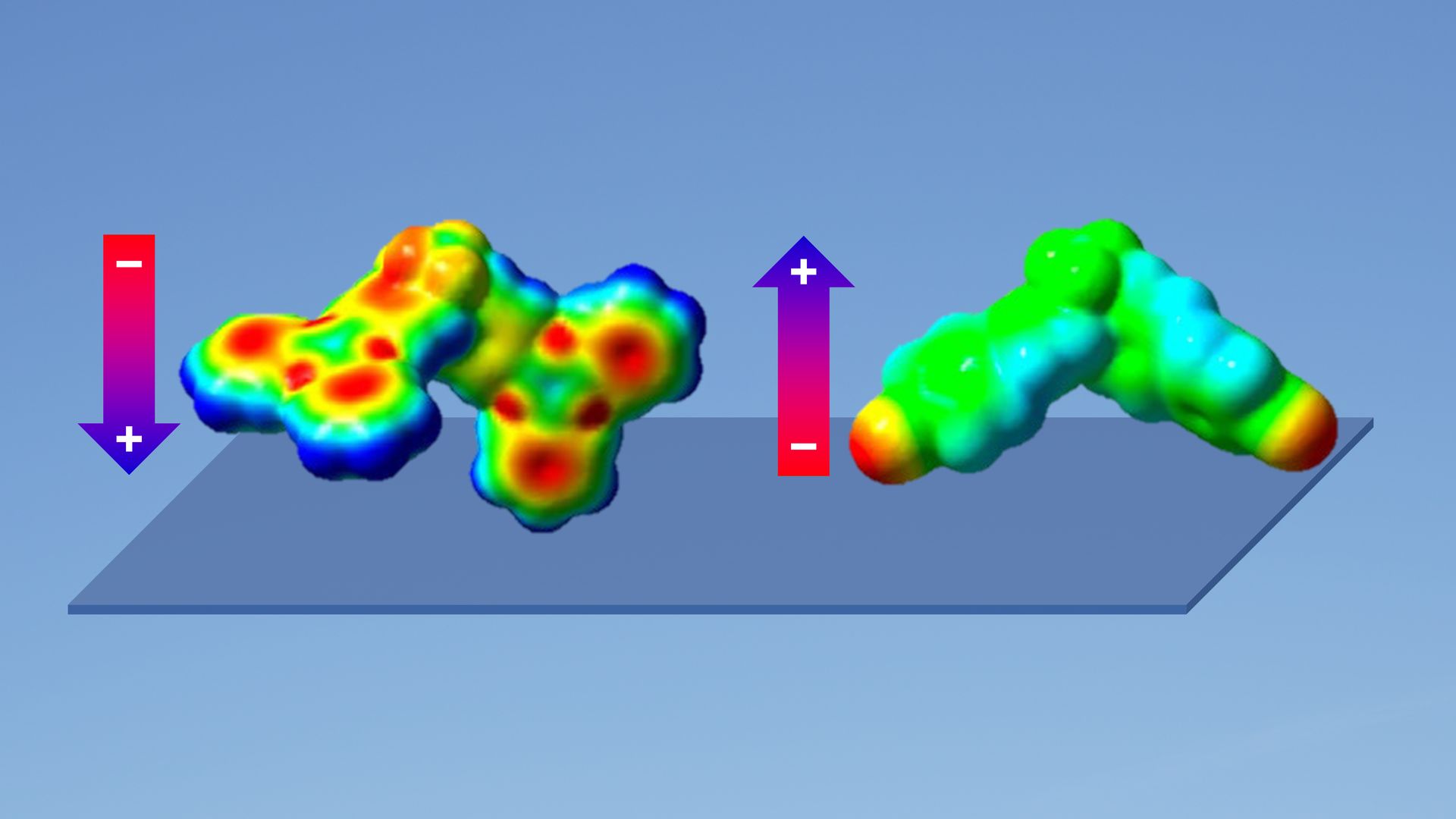研究成果 Research Results
- TOP
- News
- Research Results
- Small molecules, giant (surface) potential
Small molecules, giant (surface) potential
Researchers create organic molecules that spontaneously align on a surface to generate controlled electric fields that could improve OLED performance and lead to new devices 2022.08.26Research ResultsPhysics & ChemistryMaterialsTechnology

In a molecular feat akin to getting pedestrians in a scramble crosswalk to spontaneously start walking in step, researchers at Kyushu University have created a series of molecules that tend to face the same direction to form a ‘giant surface potential’ when evaporated onto a surface.
The researchers hope to utilize the approach to generate controlled electric fields that help improve the efficiency of organic light-emitting diodes used in displays and lighting and open new routes for realizing devices that convert vibrations into electricity with organic materials.
Based on the fantastic chemical versatility of carbon that makes living organisms possible, organic electronics are already driving a wave of vibrant—and even flexible—smartphone and television screens, with applications in solar cells, lasers, and circuits on the horizon.
This flexibility is in part due to the disordered nature of the thin films of the materials used in the devices. Unlike common inorganic electronics based on silicon atoms tightly connected in rigid, well-organized crystals, organics usually form ‘amorphous’ layers that are not nearly as neatly organized.
Despite the seemingly random organization of the molecules, researchers have found that some in fact tend to align in similar directions, profoundly impacting the properties of a device and creating new possibilities for controlling device performance.
“Significant work has already been done on molecules that align in a way that the light they emit can more easily escape a device,” says Masaki Tanaka, an assistant professor at Tokyo University of Agriculture and Technology (TUAT) who started the present work while at Kyushu University’s Center for Organic Photonics and Electronics Research (OPERA) and continued further study of the molecular alignment in amorphous films after his transfer to TUAT.
“However, other molecules were known to align in a way that puts more of their electrons on one side of the layer, leading to a so-called surface potential accompanied by an electric field. This field can help charges move into or out of a device to make it more efficient or unlock new electrical properties, but finding ways to control the formation of the field has been a challenge.”
Films used in organic electronics are usually only tens of nanometers thick—a fraction of the thickness of a human hair—and are often gradually built up by first heating an organic powder in a vacuum so it directly changes from a solid to a gas, a process known as sublimation. When molecules of the sublimed powder reach a cool surface, they stick to form a layer.
“In the gas phase, the molecules are randomly rotating and bumping into each other, so they are likely to deposit in a random direction on a film,” explains Morgan Auffray, who synthesized the molecules. “However, we found that certain molecular units with fluorine atoms will basically repel away from the deposition surface. By including these units in a molecule, we can get the deposited molecules to roughly align, with the fluorinated units facing out.”
The researchers then attached parts that push and pull negatively charged electrons toward or away from the fluorinated unit. This imbalance of charges across the aligned molecules on a surface leads to the so-called surface potential and a resulting electric field.
“Since the deposited molecules and their associated electric fields point in a similar direction, the individual tiny fields add up to produce a much larger overall field,” says Tanaka. “Not only can we get a relatively larger field, but we can get it to point toward the surface, which has been rarely reported so far.”
These layers yield a giant surface potential of nearly 10 V, which is particularly impressive when considering that it was spontaneously produced by a film only 100 nm thick.
Such a large voltage over such a small thickness produces a high electric field that can aid in getting positive and negative charges into the various layers of devices like OLEDs, thus improving overall power conversion efficiency.
Furthermore, these controlled, built-in electrical structures could aid in realizing new devices. The researchers already demonstrated that the layers could be used in a new type of device that convert vibrations into electricity, but more work remains to make such devices practical.
“Science keeps showing us new ways to control electrical processes on a smaller and smaller scale by arranging atoms in organic molecules,” says Chihaya Adachi, director of OPERA. “This research adds to our tool bag, which will make new devices possible as it continues to grow.”
###
For more information about this research, see “Spontaneous formation of metastable orientation with well-organized permanent dipole moment in organic glassy films,” Masaki Tanaka, Morgan Auffray, Hajime Nakanotani, and Chihaya Adachi, Nature Materials (2022). https://doi.org/10.1038/s41563-022-01265-7
This release is also available in Japanese.
Research-related inquiries
Chihaya Adachi, Director
Center for Organic Photonics and Electronics Research (OPERA), Kyushu University
Contact information can also be found in the full release.
- TOP
- News
- Research Results
- Small molecules, giant (surface) potential































